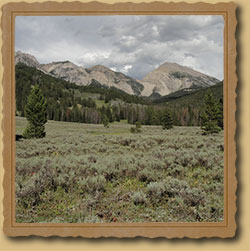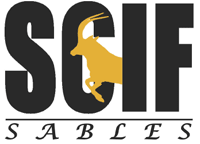Home
Mission Statement
Sables
Chapter Projects
AWLS
SCIF Blue Bag Program
SafariWish
and Disable Hunter
Hunter's Banquet
and Hunter Expo
Become a Member
and Members Meetings
Board Of Directors
Sponsor Links
American Wilderness Leadership School experience
by Sandy Vander Velden, AWLS
Wyoming graduate 2012.
“Good fences make good neighbors,” quips the neighbor in Robert Frost’s “Mending Wall.” The poem is Frost’s exploration of the forces that continuously work against the stone fence—animals, frost, gravity, hunters, the cycle of life. “Something there is that doesn’t love a wall but wants it down” writes Frost, in the realization of the wasted effort of the wall’s maintenance and divisiveness of its presence.
As human developments spread into formerly wild
areas, we continue to construct “walls” across wilderness in our efforts to ease transportation, to raise food, to extract energy resources, and to build
our homes. In and of themselves, these are not evil pursuits, but without coordinated conservation efforts our “walls”—Interstate highways, urban sprawl,
natural gas drilling rigs, and, yes, fences—are disastrous to wildlife habitat. The American Wilderness Leadership School (AWLS) provided me a new
perspective on wildlife conservation and my role in both building and tearing down the walls.
formerly wild
areas, we continue to construct “walls” across wilderness in our efforts to ease transportation, to raise food, to extract energy resources, and to build
our homes. In and of themselves, these are not evil pursuits, but without coordinated conservation efforts our “walls”—Interstate highways, urban sprawl,
natural gas drilling rigs, and, yes, fences—are disastrous to wildlife habitat. The American Wilderness Leadership School (AWLS) provided me a new
perspective on wildlife conservation and my role in both building and tearing down the walls.
Feeling the tight constraints of our walls is the sage grouse, a game bird known for its beautiful spiked tail plumage and intricate spring courtship rituals. These birds are completely dependent on sagebrush habitat. Once plentiful in northwest Wyoming, the sage grouse occupies only 58% of its original range due to habitat loss, degradation and fragmentation. The stands of sagebrush are disappearing. For more than 100 years, the grazing of livestock has disrupted the sagebrush ecosystem. More recently, our nation’s quest for energy independence has led to the opening of natural gas fields on public lands near Pinedale, WY, leased by out-of-state energy companies. As I sit in my Wisconsin home on a winter day, I enjoy the warm air circulated by my furnace run on natural gas. In July, I saw firsthand the infrastructure required to obtain this fossil fuel—roads, fencing, storage tanks, and drilling rigs. I wondered what impact this would have on local grouse. Will the human presence, the loud noises, the bright lights at night cause significant disruption to the spring mating ritual? Will the drumming of the male grouse be heard on the leks (dance arenas) by the females he is attempting to woo? These same questions are under study by the Wyoming Fish and Wildlife Service who are working with local and national hunting organizations and other nonprofit groups to implement a sage grouse conservation initiative that brings both private land owners and public land management groups together to increase sage grouse numbers by protecting and restoring its habitat.
My AWLS friends and I spent an afternoon at the National Wildlife Refuge adjacent to Jackson Hole, WY. One truly steps out of the city limits and enters the refuge. Only an 8-foot-high fence separates the two. This wall is necessary to limit human and elk encounters. Since it opened in 1912, the National Elk Refuge has been a tourist attraction. Elk have been habituated to the winter feeding program and must be gradually introduced to the high protein alfalfa pellets that are fed when the winter forage is deemed unsuitable by wildlife managers. The concern of walling the elk into these areas is that the local elk population is kept at an artificially high level. The animals do not fall to the limiting factors of starvation, predation, and harsh winter conditions as they would with our “help.” High concentrations of animals in these feeding areas make efficient spread of disease. Rather than losing the weakest animals, as would happen without human interference, an entire herd can leave the wintering grounds in a weakened condition.
While riding in the AWLS vans to Trapper’s Point, the famous rendezvous site of the North American Fur Trade, my friends and
I waited for road construction crews to allow us our turn to pass through the blockaded construction zone. Being constructed at a cost of millions of
dollars were two overpasses. These overpasses were not for human traffic, but were for antelope, elk, mule deer, and moose as they come down from summer
grazing lands in the hills
 to the Green River Basin below. These winter grounds provide needed forage with
little snow cover. The spring and fall migration of thousands of animals has been occurring for more than six thousand years and remains unchanged by
multi-lane highways or barbed-wire fences. These animals cross through this area day and night through a span of about a mile. Auto-animal collisions were
common and cost millions in injuries and property damage. In addition to the two overpasses, six tunnels were constructed for use by elk, bison, and mule
deer. The construction of these structures was a gamble but one that paid off as all were used by migrating animals for the first time this fall. The
pronghorn, or “speed goats” as they are known by locals, are particular in their travels; they only used the overpasses which allow for full view of their
surroundings and potential predators. Likewise, pronghorn antelope will not jump barbed-wire fences, but will attempt to crawl under them instead. Often
this results in pronghorn being entangled in the fencing. While at AWLS I learned how ranchers are now using drop-wire fences to allow unrestricted
movement of wildlife during the spring and fall migration. This fencing method is a win-win solution for ranchers wishing to maintain their fences for
animal enclosure purposes and for wildlife following the trails of generations.
to the Green River Basin below. These winter grounds provide needed forage with
little snow cover. The spring and fall migration of thousands of animals has been occurring for more than six thousand years and remains unchanged by
multi-lane highways or barbed-wire fences. These animals cross through this area day and night through a span of about a mile. Auto-animal collisions were
common and cost millions in injuries and property damage. In addition to the two overpasses, six tunnels were constructed for use by elk, bison, and mule
deer. The construction of these structures was a gamble but one that paid off as all were used by migrating animals for the first time this fall. The
pronghorn, or “speed goats” as they are known by locals, are particular in their travels; they only used the overpasses which allow for full view of their
surroundings and potential predators. Likewise, pronghorn antelope will not jump barbed-wire fences, but will attempt to crawl under them instead. Often
this results in pronghorn being entangled in the fencing. While at AWLS I learned how ranchers are now using drop-wire fences to allow unrestricted
movement of wildlife during the spring and fall migration. This fencing method is a win-win solution for ranchers wishing to maintain their fences for
animal enclosure purposes and for wildlife following the trails of generations.
The Grand Tetons draw sight-seers, skiers, hikers, and tourists in all seasons for the beauty, adventure and solitude available in abundance there. Viewing free-ranging wildlife in its natural environment is part of that experience as is hunting and fishing. Unlike the neighbor in Frost’s “Mending Wall,” the residents, the hunters and anglers, ranchers, and the federal government are interested in tearing down the walls that harm wildlife and its habitat. Each believes, “Something there is that doesn’t love a wall but wants it down.”
I would like to thank the Northeast Wisconsin Chapter of the Safari Club International for sponsoring my week at the American Wilderness Leadership School in Jackson, WY. The week was filled with adventure. In addition to wildlife sightings---a black bear, elk, bison, pronghorn antelope, and moose—I learned to fire hand guns, perfected my archery instructing skills, and went white-water rafting. The field trips in conjunction with the Wildlife Ecology course were the inspiration for the unit I developed for teaching my students about animal migration.

